Coal combustion residuals (CCR) have been used for many years in the construction of berms and engineered structural fill applications, including embankments for highways, dikes, and levees. However, large, unencapsulated structural fill projects have become a focus of environmental concerns due to potential leaching of metals and structural failures. Cap-in-place of CCR surface impoundments is an option for on-site closure where it is determined that there is minimal potential for current or future interaction between the CCR materials and surface water/groundwater. However, where CCR remains in direct or indirect contact with surface water/groundwater, cap-in-place alone may be inadequate to prevent releases to the environment. In these cases, clean closure via removal and off-site disposal has been the most common alternative option. However, off-site disposal can be logistically unrealistic and extremely expensive, and it may introduce its own set of environmental-sociological impacts. Thus, the industry would benefit significantly from an alternative that could provide effective and cost-competitive on-site clean closure by employing a cap system coupled with macroencapsulation controls that would isolate all CCR from the immediate environment. Additionally, established macroencapsulation technology can be used to preserve the strategic use of CCR in structural fill and mine reclamation applications where off-site management is the only workable option (Hardin and Daniels 2011).
An economically attractive and CCR-beneficial use system has been developed to offer utilities an optimal on-site clean closure option that meets all four criteria for beneficial use stipulated in 40 CFR Part 257.53. Based on patented macroencapsulation technologies using Subtitle D–compliant liner and cover systems, CCR can be used in encapsulated, mechanically stabilized earthen (eMSE) berms as part of a retrofit of existing on-site dry or wet basin footprints. Engineers can incorporate macro-encapsulation technology to increase CCR structural stability while fully isolating the CCR from the environment. Converting wet basins to dry, lined storage facilities can be carried out on-site in a manner that is economically competitive when compared with other clean closure options. The creation of a lined beneficial-use footprint, constructed in phases, could use all material stored at a facility. This method uses CCR in every facet of the coal ash management strategy, enabling facilities to set up an on-site beneficial reuse program, reduce potential environmental liability, increase stability and safety, establish a controlled system for the future recovery/recycling of CCR, and minimize the use/cost of other imported construction materials.

From waste to resource
The April 2015 final CCR disposal rule reaffirms the Environmental Protection Agency’s Bevill Amendment for beneficial use and provides a definition to distinguish between beneficial use and disposal. The beneficial use of CCR definition has four criteria:
- The CCR must provide a functional benefit.
- The CCR must substitute for the use of a virgin material.
- The CCR must meet product specifications and/or design standards.
- When unencapsulated use of CCR involves placement on the land of 11,250 metric tons (12,400 tons) or more in nonroadway applications, the user must demonstrate and provide documentation upon request that environmental releases to groundwater, surface water, soil, and air are comparable to or lower than those from analogous products made without CCR, or that releases will be below relevant regulatory and health-based benchmarks for human and ecological receptors (U.S. EPA).
Using macroencapsulation techniques, clean closure (retrofit) meets the EPA criteria for CCR beneficial use by using the material within perimeter, finger, and channeling berms that are designed with a unique drainage system. The result conforms to the fourth criteria by enhancing CCR dry storage structural stability and minimizing potential environmental impacts. Macroencapsulation solutions balance environmental stewardship with economics, enabling facilities to create an on-site CCR beneficial reuse program while controlling liability and decreasing costs. In most cases, these solutions allow the facility to consolidate the disposal footprint, further reducing risk.

Macroencapsulation allows for clean closure on-site
There are several options for CCR pond or impoundment closures, each having engineering, cost, and risk advantages and disadvantages. In most circumstances, crews will need to dewater and stabilize the site first. Table 1 shows current methods organized into three categories.
As defined, clean closure must remove all CCR from the unit and decontaminate areas affected by releases from the impoundment, including removal or decontamination of the underlying and surrounding soils and flushing, pumping, and treating the aquifer, as confirmed by groundwater-monitoring results. Based on science and technology, clean closure should be the preferred method of closure. However, the urgency for closure, as well as economic factors and logistics, have influenced some current decisions resulting in the selection of cap-in-place methods that may have to be revisited.

Retrofit wet basin to Subtitle D standards
The macroencapsulation process results in a dramatic reduction of environmental impact and liability. Using this process, most facilities have enough existing footprint to clean close their surface impoundments. The eMSE berm technology can improve structural stability, which can safely provide capacity within a discrete disposal area. The ability to raise the outer side slopes allows an increase in the CCR storage depth via controlled filling. The eMSE system consists of five components:
- Controlled fill operations: backfilling operation in which the moisture content, depth of lift, and compaction equipment can be closely regulated by specification and inspection
- Geogrid uniaxial or biaxial reinforcement: established technology for high-strength reinforcement
- High-density polyethylene (HDPE) macroencapsulation: isolates the materials from the environment
- Drainage system: proactive control of moisture, which is a principal cause of berm failure
- Specialized and berm facing: using natural or geosynthetic materials to improve aesthetics, provide better access, increase stormwater control, enhance slope stability, and make maintenance easier
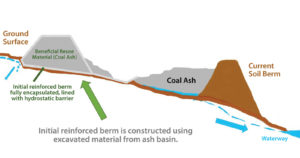
The eMSE system can include both perimeter berms (both upgradient and downgradient) and internal buttress
(finger) berms within a retrofit scenario. The buttress/finger berms create separate segments that allow the incremental removal of stored CCR materials from the overall fill while leaving intact other structural and encapsulated sections. Because CCR is continually encapsulated by the incremental berm liner/closure cap, it decreases the amount of ash that can come into contact with water; therefore, water infiltration is reduced throughout the construction process, thus reducing dewatering treatment costs, both during construction and during CCR recovery.
Retrofitting existing ash basins can follow the guidance below:
- Where environmental impacts are present: The corrective action process should prioritize maximum reduction in the risk of future impacts.
- Where impacts are not yet defined but site characteristics indicate the potential or probability of environmental impact: Closure strategies should be implemented that go beyond traditional methods (such as cap-in-place) and create a strategic path that limits the potential of future impacts. The end use of the site and the need for more dry disposal capacity factor into the choice of beneficial reuse options.
Figures 3–6 illustrate the sequential development of a typical eMSE system basin retrofit. Site-specific scenarios dictate design, development, and construction, and a benefit of the eMSE system is its flexibility of implementation.
Using macroencapsulation solutions combined with standard geosynthetic capping, the amount of material needed to fill the groundwater from below could be obtained from the existing dirt berms around the basins, minimizing cost. Where there are multiple surface impoundments, the dewatered CCRs can supply construction fill material. The existing outer soil embankment can be replaced with multiple eMSE berms using CCR to create both internal buttressing/finger berms for stabilization (and equipment access) as well as the perimeter and final downgradient berm.
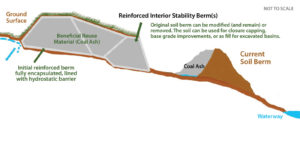
Construction in phases
After completion of the perimeter berm using material from the basin next to the berm (and potentially supplemented with ash from other basins), the area excavated to supply CCRs in berm construction can be lined (the first phase of storage). The CCR located downslope of the lined area can be excavated and placed on top of the lined area, creating space once again for construction of the first interior buttressing/finger berm.
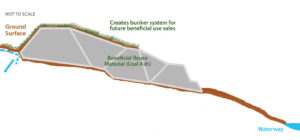
Geomembranes (geosynthetic clay liner [GCL] and 30- to 60-mil flexible membrane liner [FML]) are the preferred long-term liner remedy for areas with groundwater impacts, and GCL and/or 30-mil FML for capping. The final grade of the first-phase incremental storage unit can be capped to accelerate control of surface water infiltration. If postclosure use is intended, then the final grades can be shaped to accommodate this plan.
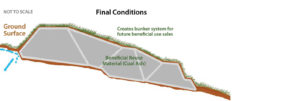
The goal of construction in phases is to minimize the chance of double-handling of CCR while ensuring each phase is properly designed to stage progressive CCR excavation and placement for the remainder of the closure. Options may include a progressive fill sequencing within the first phase or using areas of more suitable CCR to minimize the impact of double-handling.
The strength of the geogrid-reinforced berm(s) produces additional bearing capacity in the CCRs, thereby providing enough load-carrying capacity for construction equipment to access the center of the wet basin or to stabilize left-in-place CCRs. This solution requires CCRs dewatered to approximately 40–50% moisture content before use in the berm system.
All CCRs are backfilled using
controlled-fill methods that allow for consolidation of the CCR unit footprint using a Subtitle D or equivalent system.
Improving structural stability
Incorporating eMSE berms will add to the stability of the coal ash unit. The need for preexisting dams or levees will disappear, allowing the decommissioned structure to serve as a borrow source for subgrade fill or cap material. As future demand for CCR recycling increases, one section of the retrofitted fill can be excavated at a time while retaining the structural stability of the remaining eMSE berms.
Thus, macroencapsulation accomplishes on-site clean closure with the following advantages:
- All CCR is beneficially reused.
- Ash is lined and capped, and is 100% isolated from the environment.
- Ash is consolidated into the existing CCR footprint, and the footprint
is minimized. - CCR is relocated away from floodplains and sensitive areas.
- CCR mass is stabilized with reinforced encapsulated berms, improving stability of closed basins and/or dry storage units.
- Controlled fill provides stable and secure dry storage.
- Retrofit enables proactive control and management of stormwater.
- Progressive construction and closure reduces the volume of stormwater and leachate requiring treatment.
- Progressive construction and closure reduces time of closure.

Preventing system failures
Due to the nature of CCRs, use of macroencapsulation requires important engineering considerations, including reducing stormwater infiltration and the creation of acceptable pore water pressures. Water removal from a wet basin is critical to constructability, project economics, and long-term performance. Without proper dewatering of saturated ash materials before removal, excavations risk caving and slope collapse, creating safety hazards and the potential for costly repairs and environmental remediation (Johnson and Nilsson 2014).
Koerner and Koerner (2011) have studied the importance of drainage control in berm systems. The resulting guidance detailed the overwhelming necessity to design and maintain for proper drainage control in berm systems. To prevent problems, the guidance concludes, “The entire reinforced soil zone must be encapsulated by waterproofing from above the drainage from beneath and behind whatever backfill consists of fine-grained soils. These precautions are felt to be absolutely necessary to prevent berm drainage failures from occurring in the future.” Indeed, a Geosynthetic Institute study found that 68% of berm failures were internal or external water-related. In addition, 80% of failures were due to moderate-to-poor material compaction, and 76% of failures were associated with masonry block walls (Koerner and Koerner 2009). As the majority of berms constructed at waste and power facilities are vegetated berms, this eliminates the potential failure mechanisms associated with masonry block walls.
As discussed, improper design and construction methods have been cited for the majority of wall failures. When designers do not understand the systems they are designing and when proper construction quality assurance is not performed, the project has a greatly increased likelihood of failure.
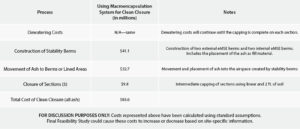
Project costs matter: Macroencapsulation offers economic advantages
Since the eMSE system uses existing coal ash as internal beneficial reuse, in most cases there are many cost-savings opportunities in material procurement, construction methods, and phasing.
- On-site clean closure costs are significantly less than that of removal and off-site disposal.
- Clean closure and lined dry storage are created simultaneously—single-handling of ash during construction and dry storage placement reduces ash management costs.
- Incorporation of the eMSE system into dry storage design allows time for the beneficial use of CCR demand to catch up with supply.
- Progressive construction and closure in phasing reduce the volume
of stormwater and leachate during
construction, which requires expensive treatment. - Some costs of macroencapsulation technology overlap with that already encumbered for current closure plans.
As shown in Table 2, on-site clean closure retrofit of a typical ash basin can be significantly less expensive than that of excavation and off-site disposal.
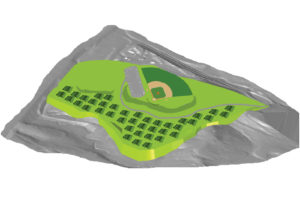
Land use matters
Clean closure allows developers to continue to use CCR as a backfill material, creating developable acreage (plateaus) for applications such as solar farms, parks, and sports fields. Final soil cover is graded to fit the end use.
The beneficial reuse material (CCR) is encapsulated and segregated from other materials, with its own leachate treatment system, as illustrated in Figure 7.

Summary
The retrofit of CCR surface impoundments using macroencapsulation technology eliminates the limited technical comparison of cap-in-place versus removal and off-site disposal. Instead, it is ideal for on-site clean closure, particularly where existing site conditions indicate that cap-in-place may not fully address current and/or future environmental impacts. The creation of macroencapsulated, reinforced berms using facility-generated CCR materials offers significant cost savings while enhancing beneficial reuse, consolidating and minimizing the footprint of CCR placement, increasing stability and safety, minimizing the potential of environmental impact, reducing costs of implementation, and promoting a controlled environment for the future recovery of stored ash for other recycling applications.
John P. Swenson is a managing partner of EnCAP-IT in Glen Allen, Va.
Jeffrey T. Crate, P.G., is president of Waste Resource Services LLC in Blacksburg, Va.
Scott Sheridan, P.E., is a senior principal civil and geotechnical engineer with Geosyntec Consultants in Richmond, Va.
References
Brown, D., and Ballod, C. (2008). “Construction details and related considerations of MSE berms at landfills.” Proc., 1st Global Waste Management Symp., Waste360, Washington, D.C.
Dudding, C. L., and Sheridan, S. K. (2013). “Mechanically stabilized earthen (MSE) berm basics: Applicability, design standards and construction quality control/assurance.” Proc., 5th World of Coal Ash Conf., American Coal Ash Association, Farmington Hills, Mich., and the University of Kentucky Center for Applied Energy Research, Lexington.
Dudding, C. L., Sheridan, S., and Brown, D. N. (2011). “Introduction of a novel approach: Beneficial reuse of CCP’s to dramatically reduce landfill airspace construction costs.” Proc., 4th World of Coal Ash Conf., American Coal Ash Association, Farmington Hills, Mich., and the University of Kentucky Center for Applied Energy Research, Lexington.
Hardin, C. D., and Daniels, J. L. (2011). “Preserving structural fill and mine reclamation as acceptable beneficial reuse of CCRs.” Proc., 4th World of Coal Ash Conf., American Coal Ash Association, Farmington Hills, Mich., and the University of Kentucky Center for Applied Energy Research, Lexington.
Johnson, M., and Nilsson, K. (2014). “Construction considerations are key in closure planning for coal ash ponds.” POWER Magazine, Dec. 1. <http://www.powermag.com/construction-considerations-are-key-in-closure-planning-for-coal-ash-ponds>
Koerner, R., and Koerner, G. (2009). “A data base and analysis of geosynthetic reinforced wall failures.” Report 38, Geosynthetic Institute, Folsom, Pa.
Koerner, R., and Koerner, G. (2011). “The importance of drainage control for geosynthetic reinforced mechanically stabilized earth wall.” J. of GeoEngineering, 6(1), 3–13.
Luettich, S., and Quiroz, J. (2008). “Landfill stability analyses for the application of mechanically stabilized earth (MSE) perimeter berms.” Proc., 1st Global Waste Management Symp., Waste360, Washington, D.C.
Qian, X., and Koerner, R. M. (2009). “Stability analysis when using an engineered berm to increase landfill space.” J. of Geotechnical and Geoenvironmental Engineering, 135(8), 1082–1091.
U.S. EPA. “Coal ash reuse.” <https://www.epa.gov/coalash/coal-ash-reuse>
 TEXTILES.ORG
TEXTILES.ORG



2 responses to “Using geosynthetics for macroencapsulation for CCR on-site clean closure”